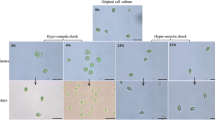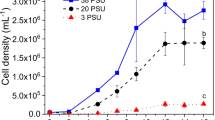Abstract
The plasma membrane from Aphanothece halophytica was isolated using both glycerol and sucrose gradient centrifugation. The isolated membrane was characterized for lipid content by TLC and isolated lipids were quantified by chemical analysis. The plasma membrane of A. halophytica was composed of MGDG, DGDG and PG. The sulfur containing lipid SQDG was not detected. The mole percent of each lipid in the plasma membrane varied with the external salinity of the media. MGDG was the most abundant lipid in the plasma membrane of cells grown at one molar external NaCl. At three molar external NaCl, PG was the most abundant lipid. The ratio of uncharged to charged lipids comprising the plasma membrane decreased as the external salinity increased. It is possible that the alteration in lipid composition is of major importance in the adaptation of A. halophytica to changing external salinity.
Similar content being viewed by others
Abbreviations
- TLC:
-
Thin-layer chromatography
- MGDG:
-
momogalactosyldiacylglycerol
- DGDG:
-
digaloctosyldiacylglycerol
- PG:
-
phosphatidylglycerol
- SQDG:
-
sulphoquinovosyldiacylglycerol
References
BlightE, DyerW (1959) A rapid method of total lipid extraction and purification. Can J Biochem Physiol 37: 911–917
BlumwaldE, WolosinJM, PackerL (1984) Na+/H+ exchange in the cyanobacterium Synechococcus 6311. Biochem Biophys Res Commun 122: 452–459
BrownJS (1982) Chlorophylls of pants and algae. In: ZaborskyOR (ed) Handbook of biosolar resources. CRC Press, Boca Raton
DaviesBH (1976) Carotenoids. In: GoodwinTW (ed) Chemistry and biochemistry of plant pigments, vol 1. Academic Press, New York, pp 38–165
DaviesBH (1982) Carotenoids of photosynthetic bacteria. In: ZaborskyOR (ed) Handbook of biosolar resources, vol 2. CRC Press, Boca Raton 73–78
DuboisM, GillesKA, HamiltonJK, RebersPA, SmithL (1956) Colorimetric method for determination of sugars and related substances. Anal Chem 28: 350–356
ErberWWA, NitschmannWH, MuchlR, PeschakGA (1986) Endogenous energy supply to the plasma membrane of dark aerobic cyanobacterium Anacystis nidulans; ATPase independent efflux of H+ and Na+ from respiring cells. Arch Biochem Biophys 247: 28–39
HardwoodJL, RusselNJ (1984) Lipids in plants and microbes. George Allen and Unwin, London
HerdmanM, JanvierM, RippkaR, StanierRY (1979) Genome size of cyanobacteria. J Gen Microbiol 111: 73–85
HuflejtME, TremolieresA, PineauB, LangJK, HathewayJ, PakcerL (1990) Changes in membrane lipid composition during saline growth of the fresh water cyanobacterium Synechococcus 6311. Plant Physiol 94: 1512–1521
KateM, (1972) Techniques of lipidology. North-Holland, Amsterdam
KatesM (1986) Influence of salt concentration on membrane lipids of halophilic bacteria. FEMS Microbiol Rev 39: 95–101
KhanM, WilliamsJP (1977) Improved thin-layer chromatographic method for the separation of major phospholipids and glycerolipids from plant extracts and phosphatidyl glycerol and bis(monoacylglycerol) phosphate from animal lipid extracts. J Chromatography 140: 179–185
KogutM, RusselNJ (1984) The growth and phospholipid composition of a moderately halophilic bacterium during adaptation to changes in salinity. Curr Microbiol 10: 95–98
MolitorV, ErberW, PeschakGA (1986) Increased levels of cytochrome oxidase and sodium-proton antiporter in the plasma membrane of Anacystis nidulans after growth in sodium enriched media. FEBS Lett 204: 251–256
MolitorV, PeschekGA (1986) Respiratory electron transport in plasma and thylakoid membrane preparations from the cyanobacterium Anacystis nidulans. FEBS Lett 195: 145–149
MolitorV, TrnkaM, PeschekGA (1987) Isolated and purified plasma and thylakoid membranes of the cyanobacterium Anacystis nidulans containing immunologically cross-reactive aa3-type cytochrome oxidase. Curr Micrbiol 14: 263–268
MurataN, SatoN, OmataT, KuwabaraT (1981) Separation and characterization of thylakoid and cell envelope of the blue-green alga (cyanobacterium) Anacystis nidulans. Plant Cell Physiol 22: 855–866
OlieJ, PottsM, (1986) Purification and biochemical analysis of the cytoplasmic membrane from the desiccation-tolerant cyanobacterium Nostoc commune UTEX 584. Appl Environ Microbiol 52: 706–710
OmataT, MurataN (1983) Isolation and characterization of the cytoplasmic membranes from the blue-green alga (cyanobacterium) Anacystis nidulans. Plant Cell Physiol 24: 1101–1112
OmataT, MurataN (1984) Isolation and characterization of three types of membranes from the cyanobacterium (blue-green alga) Synechocystis PCC 6714. Arch Microbiol 139: 113–116
PackerL, SpathS, MartinJB, RobyC, BlignyR (1987) 23Na and 31P NMR studies of the effects of salt stress on freshwater the cyanobacterium Synechococcus 6311. Arch Biochem Biophys 256: 354–361
PeschekGA, HinterstoisserB, WastynM, KuntnerO, PineauB, MissbichlerA, LangJ (1989) Chlorophyll precursors in the plasma membrane of a cyanobacterium, Anacystis nidulans. J Biol Chem 262: 11827–11832
RippkaR, DeruellesJ, WaterburyJB HerdmannM, StanierRY (1979) Generic assignment, strain historiesand properties of pure cultures of cyanobacteria. J Gen Microbiol 11: 1–61
RoughhamPG, BattRD (1968) Quantitative analysis of sulfolipid (sulfoquinovosyl diglyceride) and galactolipids (monogalactosyl and digalactosyl diglycerides) in plant tissue. Analytical Biochem 22: 74–88
StoneBB, BoussibaS, GibsonJ (1988) Penicillin-binding proteins in the unicellular cyanobacterium Synechococcus sp. stain R2 (PCC 7942) implications for membrane identification. J Gen Microbiol 134: 2951–2958
TakabeT, IncharoensakdiA, ArakawaK, YokotaS (1988) CO2 fixation rate and RuBisCO increase in the halotolerant cyanobacterium, Aphanothece halophytica, grown in high salinities. Plant Physiol 88: 1120–1124
YoppJH, TindallDR, MillerDM, SchmidWE (1978a) Isolation, purification and evidence for a halophilic nature of the blue-green alge Aphanothece halophytica Fremy (Chroococcales). Phycologia 17: 172–178
YoppJH, MillerDM, TindallDR (1978b) Regulation of intracellular water potential in the halophilic blue-green alge Aphanothece halophytica (Chroococcales). In: SRCaplan, MGinzburg (eds) Energetics and structure of halophilic microorganisms. Elevier/North-Holland Biomedical Press, Amsterdam pp 619–624
Author information
Authors and Affiliations
Rights and permissions
About this article
Cite this article
Ritter, D., Yopp, J.H. Plasma membrane lipid composition of the halophilic cyanobacterium Aphanothece halophytica . Arch. Microbiol. 159, 435–439 (1993). https://doi.org/10.1007/BF00288590
Received:
Accepted:
Issue Date:
DOI: https://doi.org/10.1007/BF00288590




